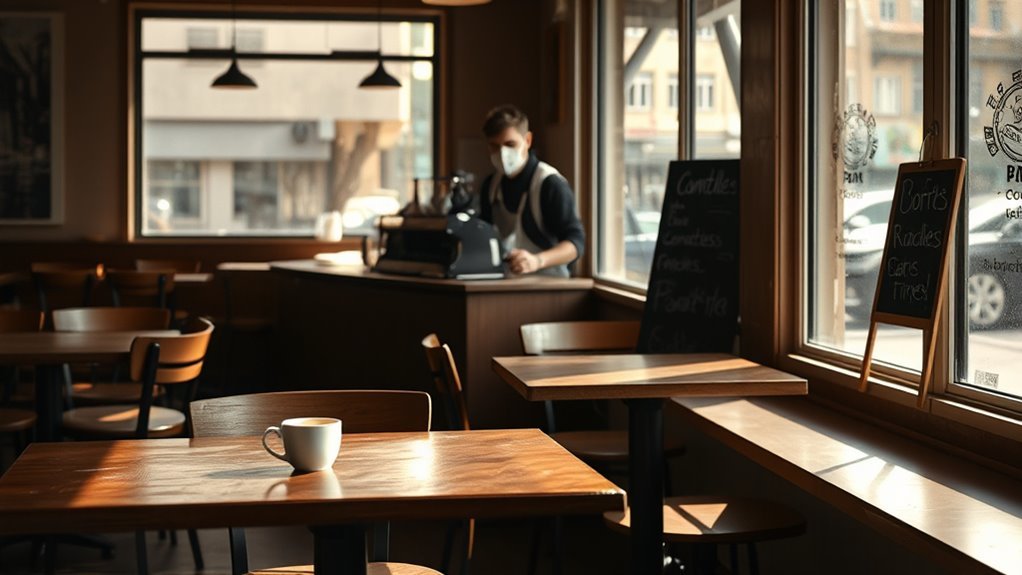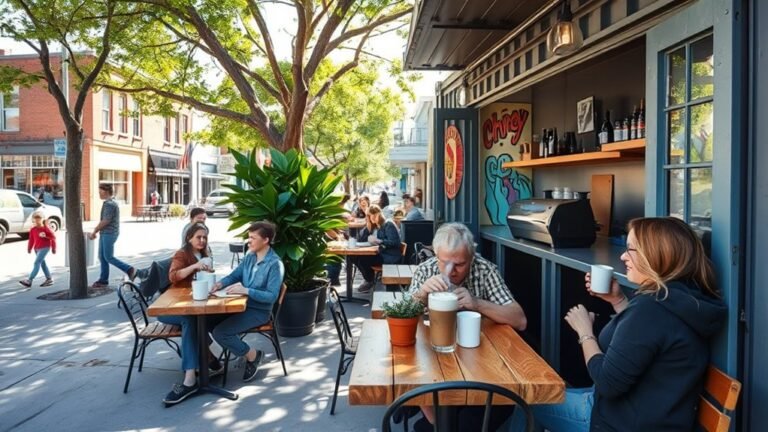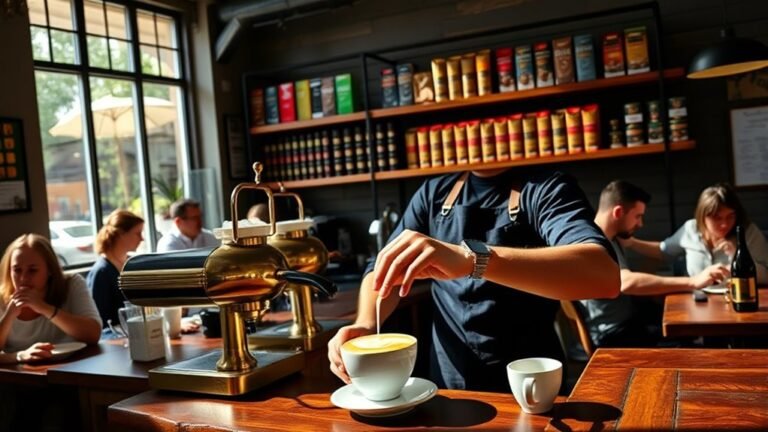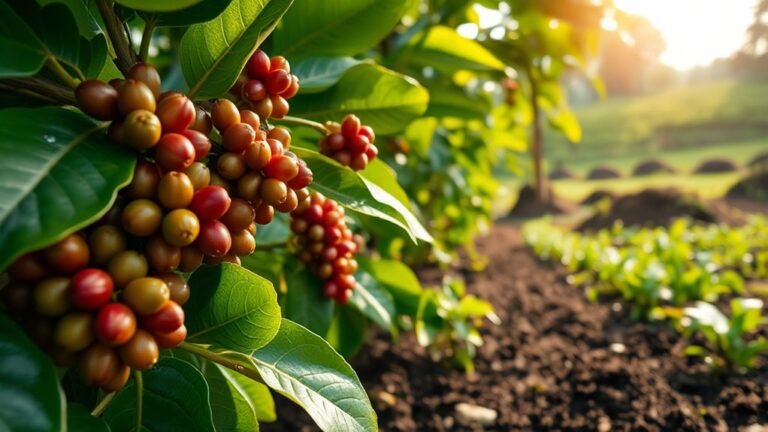The Impact of COVID-19 on the Coffee Industry
You’ve seen how COVID-19 slashed coffee exports by 15% and exposed supply chain weaknesses with labor shortages and shipping delays. Farmers faced income volatility and harvest challenges, while consumer habits shifted toward home brewing and ethical choices. Retailers adapted with health protocols and digital strategies. Innovations like AI and sustainable methods helped boost resilience. The industry’s recovery hinges on embracing these changes and meeting evolving demands—explore further to understand these transformations in detail.
Disruptions in Coffee Supply Chains

Though coffee is a globally traded commodity, the COVID-19 pandemic exposed significant vulnerabilities in its supply chains. You’ve likely noticed how sourcing challenges emerged as key exporting countries faced labor shortages and movement restrictions, limiting access to quality beans. Logistics disruptions compounded these issues, causing delays at ports and restricting transportation routes. Container shortages and increased shipping costs further strained the supply chain. Data from 2020 showed a 15% decrease in coffee exports from major producers like Brazil and Vietnam. For you, this meant a less predictable supply and potential price volatility. Understanding these challenges reveals how interconnected and fragile the coffee supply chain is, underscoring the need for more resilient sourcing and logistics strategies to secure your access to this cherished commodity in future crises.
Effects on Coffee Farmers and Producers
As the pandemic disrupted supply chains, coffee farmers and producers faced unprecedented challenges that directly impacted their livelihoods. You’ve likely noticed that price volatility intensified, driven by export restrictions and fluctuating demand. Labor challenges emerged as health regulations limited workforce availability during critical harvest periods, affecting crop yields. Sustainable practices and farmer cooperatives became essential in maneuvering through these obstacles, providing community support and shared resources. Fair trade initiatives helped stabilize incomes amid the uncertainty while promoting resilience against climate impact exacerbated by the pandemic. Data shows that farms engaged in cooperative models were better positioned to adapt, maintaining more consistent output despite disruptions. Understanding these dynamics is significant if you want to appreciate how deeply intertwined health policies and economic factors reshaped the coffee production landscape during COVID-19.
Changes in Consumer Coffee Consumption Patterns
The challenges faced by coffee farmers and producers during the pandemic went hand in hand with notable shifts in how consumers approached their coffee habits. With remote work becoming the norm, you likely embraced home brewing, exploring specialty blends and subscription services for convenience and variety. Health trends also influenced choices, increasing demand for ethically sourced and organic options. Your coffee rituals adapted, balancing quality with simplicity.
| Consumer Shift | Description |
|---|---|
| Home Brewing | Increased due to remote work and convenience |
| Specialty Blends | Preference for unique, high-quality flavors |
| Ethical Sourcing | Greater demand aligned with health trends |
| Subscription Services | Popular for regular, effortless supply |
These data-driven trends reveal your evolving relationship with coffee, prioritizing quality, ethics, and convenience.
Impact on Coffee Retailers and Cafés

While consumer habits shifted toward home brewing, coffee retailers and cafés faced significant operational challenges and revenue declines during the pandemic. You had to quickly implement stringent health protocols to guarantee safety, which often meant retraining staff and adjusting store layouts. Customer experience became more digital-focused, with many relying on delivery services and contactless payments. To retain loyalty, businesses expanded loyalty programs and adapted marketing strategies emphasizing community engagement and local support. Pricing adjustments were necessary to offset increased costs and fluctuating demand. Data indicates that cafés incorporating flexible delivery options and transparent communication saw a 20% higher customer retention rate. Ultimately, your ability to adapt operationally and maintain meaningful connections determined resilience in this turbulent period.
Innovations and Adaptations in Coffee Production
Though the pandemic disrupted traditional coffee production methods, you’ve seen a rise in innovations designed to boost efficiency and sustainability. Producers increasingly adopt technology integration, such as AI-driven monitoring and automated harvesting, to mitigate labor shortages and optimize yield. Sustainable practices, including water recycling and agroforestry, reduce environmental impact while enhancing crop resilience. These shifts empower you to support a coffee industry that values freedom through responsible stewardship and advanced methods.
| Innovation Type | Purpose | Impact |
|---|---|---|
| AI Monitoring | Crop health assessment | 15% yield increase |
| Automated Harvesting | Labor efficiency | 30% reduction in manual labor |
| Water Recycling | Resource conservation | 40% less water usage |
| Agroforestry | Biodiversity preservation | Enhanced ecosystem services |
| Solar Drying | Energy efficiency | 25% lower carbon footprint |
The Role of E-commerce in Coffee Sales
You’ve likely noticed how online marketplaces have surged, making it easier to buy coffee without stepping into a store. With digital payments becoming the norm, transactions are faster and more secure, encouraging more frequent purchases. Plus, virtual coffee tastings have emerged as innovative ways to connect consumers with brands, boosting engagement and sales.
Growth of Online Marketplaces
As consumer behaviors shifted during the COVID-19 pandemic, e-commerce platforms became essential channels for coffee sales, accounting for a significant increase in online transactions. You’ve likely noticed the rise in online coffee subscriptions, which offer convenience and variety. Virtual barista training also surged, enhancing consumer engagement remotely. This growth reflects a broader trend: marketplaces expanded their coffee categories, making it easier for you to explore specialty brews.
| Metric | Growth Rate (%) |
|---|---|
| Online Coffee Subscriptions | 45 |
| Virtual Barista Training | 60 |
| Marketplaces Offering Coffee | 35 |
| Average Transaction Value | 20 |
These figures show how online marketplaces have reshaped coffee purchasing, granting you greater freedom and choice in how you enjoy your daily brew.
Digital Payment Adoption
The surge in online coffee sales brought by e-commerce platforms has gone hand in hand with a rapid increase in digital payment adoption. You’ve likely noticed how mobile payments and contactless transactions have become the norm, offering convenience and safety. Data shows that since early 2020, mobile payment usage in coffee purchases rose by over 40%, reflecting a shift toward frictionless checkout experiences. This trend isn’t just about technology—it’s about giving you freedom to shop anywhere, anytime, without physical cash or cards. E-commerce’s integration with digital wallets and QR codes streamlines your buying process while minimizing health risks. As a result, coffee vendors who embraced these payment methods saw a 25% boost in online sales, demonstrating that digital payment adoption is essential for thriving in today’s coffee market.
Virtual Coffee Tastings
Three out of five coffee enthusiasts have participated in virtual coffee tastings since 2020, highlighting the growing influence of e-commerce beyond simple transactions. These virtual experiences offer you an accessible way to explore diverse coffee profiles, maintaining sensory engagement despite physical distance. Data shows that virtual tastings increased e-commerce coffee sales by 30% during the pandemic, as consumers sought interactive, educational experiences. By connecting you directly with roasters and experts, these events foster a deeper appreciation for coffee craftsmanship. This shift empowers you to curate your own coffee journey, breaking free from traditional retail constraints. As virtual coffee tastings evolve, they’re becoming a crucial channel for coffee brands to engage customers, enhance loyalty, and drive sales through meaningful, sensory-rich online experiences.
Future Outlook for the Global Coffee Industry

While uncertainties remain due to ongoing pandemic effects, projections suggest global coffee consumption will grow at an annual rate of approximately 2.5% over the next five years. You can expect market recovery to be driven by increased demand in emerging markets and a rebound in on-premise consumption as restrictions ease. Sustainability trends will play a vital role, with consumers favoring ethically sourced and environmentally friendly coffee, pushing producers to adopt greener practices. Innovations in supply chain transparency and digital engagement will empower you to make informed choices. Though challenges like climate change and supply disruptions persist, the industry’s adaptive capacity signals resilience. If you’re involved in the coffee sector, staying aligned with these trends will be key to capitalizing on growth opportunities and meeting evolving consumer expectations.
Frequently Asked Questions
How Did COVID-19 Affect Coffee Prices Globally?
You’ve probably noticed coffee price fluctuations during uncertain times. When market demand dropped due to lockdowns, prices initially fell as cafes closed and consumption shifted. But as demand recovered, supply chain disruptions caused unpredictable spikes. Understanding these patterns helps you see how global factors influence prices, giving you the freedom to make informed choices whether you’re buying or investing in coffee products.
Were There Any Changes in Coffee Quality Due to the Pandemic?
Isn’t it ironic that despite all the disruptions, coffee quality didn’t plummet during the pandemic? You’d expect supply chain chaos to ruin your morning brew, but it mostly didn’t. Instead, shifts in consumer preferences pushed producers to maintain or even improve quality, focusing on specialty beans. Data shows quality consistency remained stable, proving that freedom in choice and demand can keep standards high, even when logistics get messy.
Did COVID-19 Impact Coffee-Related Employment Rates?
You’ve likely noticed that coffee-related employment rates shifted during the pandemic. Remote work reduced foot traffic in cafes, causing many to cut staff or close temporarily. Consumer behavior changed, with more people brewing at home, decreasing demand for baristas and retail workers. However, some roles in online sales and delivery grew. This data shows your coffee experience adapted to new freedoms but also affected jobs across the industry in complex ways.
How Did the Pandemic Influence Coffee Trade Policies?
Imagine a barista scrambling to serve customers as the espresso machine sputters—trade regulations during the pandemic acted like that machine, disrupting the smooth flow of the coffee supply chain. You’ve seen how governments tightened import-export rules to safeguard local markets, causing delays and increased costs. This shift forced you to rethink sourcing strategies, balancing freedom in trade with necessary controls, highlighting how policy adjustments can ripple through global coffee commerce.
Were Specialty Coffee Events or Competitions Affected by COVID-19?
You’ll find that specialty coffee events faced significant disruptions during the pandemic, with many event cancellations to comply with health guidelines. However, organizers adapted quickly, shifting to virtual competitions, which allowed participants worldwide to engage freely without travel restrictions. This shift maintained industry momentum, though it altered networking dynamics. Data shows virtual formats increased accessibility but challenged traditional in-person experiences, offering a new model for future competitions balancing freedom and safety.






